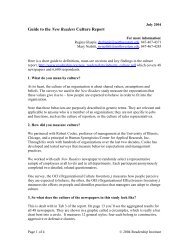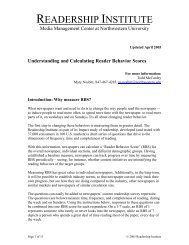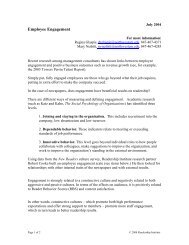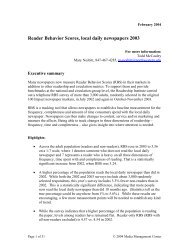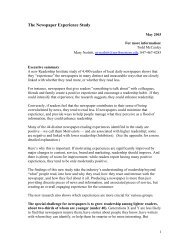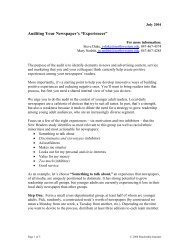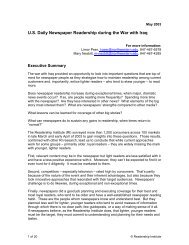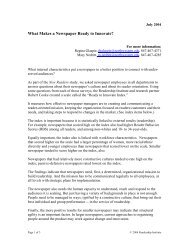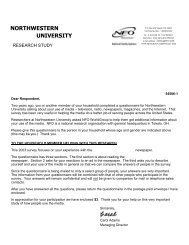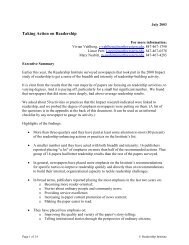Ads Content Analysis Form Instructions - Readership Institute
Ads Content Analysis Form Instructions - Readership Institute
Ads Content Analysis Form Instructions - Readership Institute
You also want an ePaper? Increase the reach of your titles
YUMPU automatically turns print PDFs into web optimized ePapers that Google loves.
New Readers Project<br />
<strong>Ads</strong> <strong>Content</strong> <strong>Analysis</strong> <strong>Form</strong><br />
<strong>Instructions</strong><br />
Fill out one form per ad.<br />
Below you will find definitions of each of the questions and how to answer them.<br />
Ad ID<br />
Total of 12 digits: newspaper code – date – ad number (xxx-xxxxxx-xxx)<br />
Newspaper code: Three digits.<br />
For example, 108.<br />
Date: Six digits.<br />
For example, September 16, 2002 is 091602.<br />
Ad number: Three digits.<br />
<strong>Ads</strong> numbered on copy of newspaper.<br />
For example, 074.<br />
The correct Ad ID in this example is: 108-091602-074<br />
Coder<br />
Coder ID number.<br />
Key words in ad<br />
Write key words in the ad for easy identification.<br />
Front page of section<br />
Mark (1) if the ad appears on the front page of a section, (2) it if doesn’t.<br />
Section<br />
Mark the section that the ad appears in from the list below using the appropriate<br />
number. A section is a stand-alone entity, not just a themed page. Be careful not<br />
to confuse the ad’s content with the section in which it appears. (Note: you can<br />
modify this list to reflect your newspaper specifically.) See Quick Reference Code<br />
List for section codes.<br />
Above fold<br />
The fold is the mid-point of the newspaper page vertically (i.e., separates top<br />
from bottom).<br />
Mark (1) if the ad is placed above the fold (or the top half of the page) (2) if is<br />
not.<br />
Size<br />
What is the most appropriate size of the ad relative to the size of the page?<br />
Mark (1) if the ad is a full page or more, (2) if the ad is ½ page to a full page,<br />
(3) if the ad is ¼ page to ½ page and (4) if the ad is ¼ page or less.<br />
Advertising <strong>Content</strong> <strong>Analysis</strong> <strong>Form</strong> <strong>Instructions</strong> 1 © 2004 <strong>Readership</strong> <strong>Institute</strong>
New Readers Project<br />
Ad <strong>Form</strong>at<br />
There are two choices: Display Advertising and Classified Advertising.<br />
Display Advertising is printed advertising that depends upon a variety of visual<br />
and copy elements to present the message. It is defined by a border. Most of the<br />
ads you code will be display ads.<br />
Classifieds advertising typically consists of one-column ads that are placed in the<br />
classified section of the paper and run without borders. While ads in the<br />
Classifieds section are not included in this study, we did include classified ads<br />
outside the Classifieds section. They are to be coded as one ad.<br />
Mark (1) if the ad is a display ad, and (2) if the ad is a classified ad.<br />
Ad Type<br />
About 90% of the ads in a newspaper sell or promote products or services.<br />
Products are defined as tangible goods such as clothes, food, loans, and furniture<br />
but also movies, basketball games and other entertainment. Services are defined<br />
as non-tangible goods such as education, legal advice and financial advice.<br />
A smaller number of ads are announcements of meetings open to the public (e.g.,<br />
city council, a rally, a lecture). These meetings may or may not be designed to<br />
enhance sales (e.g., book signing by an author). They should be coded as events.<br />
These ads offer you to go to a certain place at a certain time, ask that you be<br />
somewhere. This can be for a meeting or a seminar, but also for a grand opening<br />
of a store, or a book signing.<br />
Fewer ads are used to make a public statement by corporations, public institutions<br />
or private people. A position statement refers to an institution, group or<br />
individual’s public announcement about a public matter. For example, a lobbying<br />
group making the case against a new health care policy, or a university publishing<br />
it’s union agreement. Another example may be the government sponsoring an<br />
anti-smoking campaign (a PSA). A personal message refers to ads that publish an<br />
institution’s, group’s or individual’s public announcement about a private matter.<br />
Examples include a sympathy ad from the store where the deceased worked or<br />
congratulating a couple for their 50 th anniversary as well as death and legal<br />
notices.<br />
Mark (1) if the ad sells or promotes a product or service, (2) if the ad promotes or<br />
calls an event, (3) if the ad publishes a position statement on a public matter, (4) if<br />
the ad publishes a personal message, and (99) if the ad doesn’t fit the above<br />
categories. For example, ads recruiting people for clinical trials or other studies<br />
(please specify on the coding sheet how you would characterize this ad).<br />
Ad Category<br />
The categories we have listed are primarily goods (tangible and non-tangible).<br />
All ads selling or promoting products, services or events can be categorized. In<br />
most cases, positions statement and personal message ads can also be categorized<br />
according to this list. Mark (99) if the ad doesn’t fit the above categories (please<br />
specify on the coding sheet how you would characterize this ad).<br />
Advertising <strong>Content</strong> <strong>Analysis</strong> <strong>Form</strong> <strong>Instructions</strong> 2 © 2004 <strong>Readership</strong> <strong>Institute</strong>
New Readers Project<br />
See Quick Reference Code List for category codes and appendix at the end for<br />
more details.<br />
Ad Technique<br />
<strong>Ads</strong> fall into two categories. Some ads give you very specific, concrete<br />
information you need to make a transaction (usually to buy something or go<br />
somewhere). They’ll tell you how by focusing on a product, giving you a price,<br />
telling you there’s a sale going on, telling you how to buy tickets, where to go and<br />
what time it starts. The ads have a direct benefit to you; they are useful.<br />
Examples include Marshall Field’s 13-hour sale.<br />
Other ads are designed to sell you an image. They often don’t specify product<br />
information, list a price, give a street address, or tell you that you have to hurry to<br />
get it while supply lasts. These ads try to sell you an idea, the concept of the<br />
brand – these ads focus on why you should buy but they don’t directly ask you to<br />
do anything. They may try to appeal to an emotional need you have or to<br />
present a solution to a problem. Think of VW ads on TV.<br />
Mark (1) if it is a how ad and (2) if it is a why ad.<br />
Use of Color<br />
Is the printed in ad black and white, or is it in color?<br />
Mark (1) if the ad is B&W, (2) if there’s one additional color and (3) if there are<br />
two or more additional colors.<br />
Check List Items<br />
For the checklist items you need to mark (1) “yes” if they appear in the ad and (2)<br />
“no” if they do not appear in the ad.<br />
Promotion Device<br />
• Price Reduction / Sale – Mention of reduced prices or a general sale.<br />
Includes sales, % off, savings of $, lower price for limited time, “$$$<br />
back” (which may also be coded as rebate), “buy one get one free.”<br />
• Non-Commercial Event Promotion – Mention of a non-commercial event<br />
such as a town hall meeting or public rally. For a book signing event you<br />
can put “no” (2) for non-commercial event because the intent is to<br />
promote and sell the book, but for a meeting with the mayor you can out<br />
“yes” (1) for non-commercial event.<br />
• Technical / Description – Technical or descriptive text about the<br />
product/ service/ event and its qualities.<br />
• Competitive Comparison – text comparing the features product/<br />
service/ event to another specific product/ service/ event.<br />
• Narrative story – Text telling a story in which the product/ service/<br />
event may or may not feature. The story is not about the product (that<br />
would be technical / description). Includes “before and after” photos or<br />
illustrations (they tell a story) and testimonials<br />
Advertising <strong>Content</strong> <strong>Analysis</strong> <strong>Form</strong> <strong>Instructions</strong> 3 © 2004 <strong>Readership</strong> <strong>Institute</strong>
New Readers Project<br />
• Contest/ Raffle/ Draw – Mention of a possibility to win a prize. Includes<br />
auctions.<br />
• Free Gift – Mention of a free gift. Has to be an actual gift (with<br />
purchase, registration, etc.) not free shipping or registration. Does NOT<br />
include free estimate / delivery / shipment / registration / inspection /<br />
demonstration / “buy 1 get 1 free.”<br />
• Coupon – Ad includes a coupon or a “mention this ad to get discount”.<br />
• Prices listed – Ad includes a price. Includes $, $/month, $/x months,<br />
rates (APR, APY)<br />
Time factor<br />
• Limited Offer – Text indicating that a sale / promotion is limited in time<br />
(e.g., “One day only,” “Sale ends Monday”). The limit is on the action of<br />
the consumer. Does not apply to events that happen on a certain date<br />
(e.g., a hockey game, a concert).<br />
Contact information<br />
• Street Address – Ad includes a street address.<br />
• Local? – Is the street address provided local?<br />
• Phone / Fax – Ad includes a telephone and / or fax number.<br />
• Local? – Is the phone / fax number provided local? Any 800 or 900<br />
number is not considered local<br />
• Web Address – Ad includes a URL or Web address.<br />
Photo / Illustration<br />
• Logo – Ad includes a photo / illustration of the company or product logo<br />
(a specially designed name or symbol of a company or product used as<br />
a trademark in advertising and other communications).<br />
• Product – Ad includes a photo / illustration of the product. Includes<br />
photos of people in movies, theater, musical shows, clubs of all kind.<br />
• People – Ad includes a photo / illustration of people.<br />
Language<br />
• Spanish Language – Ad includes a word or a phrase in Spanish, or the<br />
ad is entirely in Spanish. Includes “Se Habla Espanol.” Exclude names of<br />
people, places or food.<br />
• 1 st or 2 nd Person – Ad includes the words “I,” “me,” “we,” “our,” “you,”<br />
“you’re,” or “yours”.<br />
Demographic Focus<br />
Determine if the ad is focused on one of the following groups: African-American/<br />
Black, Latin/ Hispanic, Asian-American/ Asian, Women, Youth/ Young adults.<br />
The question to ask is: Is the race/ ethnicity, the age or the gender of the people/<br />
places/ events presented a focus of the ad? (not necessarily THE focus but A<br />
focus)<br />
Advertising <strong>Content</strong> <strong>Analysis</strong> <strong>Form</strong> <strong>Instructions</strong> 4 © 2004 <strong>Readership</strong> <strong>Institute</strong>
New Readers Project<br />
Some rules of thumb:<br />
• The ad explicitly refers to ethnic minorities/ women/ young people as<br />
beneficiaries of the product/ service/ event. For example, an ad saying<br />
“serving the Hispanic community for over 20 years.”<br />
• The ad explicitly refers to ethnic minorities/ women/ young people as a<br />
target audience for the product/ service/ event. For example, an ad<br />
saying “We know what your teenager needs – buy X.”<br />
• A photo/ illustration is not enough! A photo of an African-American<br />
couple at a bank does not qualify as demographic focus.<br />
• If more than one category is applicable, give priority in this order:<br />
Age (if 34 and under)<br />
Race / Ethnicity (if African American, Hispanic, or Asian)<br />
Gender (if women)<br />
Mark 1 – 5 to indicate which group the ad is focused on. Mark 98 if the ad does<br />
not have a demographic focus and 99 if it has a strong focus on another group not<br />
listed above.<br />
Additional Number of <strong>Ads</strong> on Page<br />
Count how many other ads appear on the same page as the ad you coded. Mark<br />
the additional number of ads, excluding the one you are coding.<br />
Person #<br />
If people are shown in the ad (either in photo or illustration), each person should<br />
be coded. A person is coded as such if you can see a face (i.e., hands and other<br />
body parts do not count as a person).<br />
In case of a group shot in which there are more than ten people you can clearly<br />
identify, code the ten most prominent ones.<br />
For each person you will need to record gender, capacity, race/ ethnicity and<br />
age, based on reasonable assumptions. Don’t over-analyze; think of how a typical<br />
person would see these people and what sort of attributions a typical person<br />
would make about gender, age, and race/ ethnicity. Obviously, if there are hints<br />
in the text of the ad, use them for coding.<br />
You have the option of coding (98) if you cannot tell a person’s gender, capacity,<br />
race/ ethnicity or age.<br />
Gender<br />
Identify each person as male or female when possible.<br />
Mark (1) if the person is female, (2) if male, (98) if can’t tell.<br />
Capacity<br />
Refers to the type of person and their role in the ad. Each person should be<br />
classified as one of the following:<br />
1. Ordinary Person: People like you and me, people who don’t represent an<br />
organization, ordinary people doing ordinary everyday things. Includes<br />
people who look like ordinary people but may be professional models.<br />
Advertising <strong>Content</strong> <strong>Analysis</strong> <strong>Form</strong> <strong>Instructions</strong> 5 © 2004 <strong>Readership</strong> <strong>Institute</strong>
New Readers Project<br />
2. Official: Elected and government officials or quasi-officials (e.g., Sierra Club<br />
spokesperson, school principal, program director). Also includes political<br />
leaders (unelected, e.g., Jesse Jackson), business leaders, religious leaders and<br />
sports teams’ coaches and owners etc.<br />
3. Celebrity: Members of the entertainment industry, professional athletes,<br />
including well-recognized professional models. Also includes actors shown in<br />
movie, theater or other entertainment ads.<br />
98. Can’t tell<br />
99. Other: Can’t fit into any of above categories. Avoid as much as possible.<br />
Race / Ethnicity<br />
Refers to the person’s race or ethnicity. Identify race or ethnicity from photos,<br />
explicit mentions in the text, or general knowledge.<br />
Mark 1 – 4 to indicate which group the person in the ad belongs to, mark (98) if<br />
you can’t tell the person’s race/ ethnicity.<br />
See Quick Reference Code List for codes.<br />
Age<br />
Refers to the person’s age in years. Identify age from photos, explicit mentions in<br />
the text, or general knowledge (e.g., if the story mentions a child, it’s OK to infer<br />
he is under 18).<br />
Mark 1 – 3 to indicate which age group the person in the ad belongs to, mark (98)<br />
if you can’t tell the person’s age.<br />
See Quick Reference Code List for codes.<br />
Local<br />
Indicates whether the person shown in the ad is identified in the ad as a local<br />
person. There are two conditions under which you code a person as local:<br />
• There is an explicit mention in the ad that a person lives on a local street,<br />
that they are the owner of a local business, or they are part of a local<br />
organization or business. For example, “John Doe owner of the Main<br />
Street Bakery can’t live without his cell phone.”<br />
• It is general enough knowledge that anyone would know this without<br />
being an expert. For example, if you are coding the Chicago Tribune<br />
and there’s a pizza ad with Oprah in it, it is safe to say most people<br />
would consider her a local Chicago person.<br />
Mark (1) if the person is identified as local and (2) if not.<br />
Headline Effectiveness<br />
The headline of the ad is the top text. It is typically in bigger, bolder font, and not<br />
very long.<br />
Advertising <strong>Content</strong> <strong>Analysis</strong> <strong>Form</strong> <strong>Instructions</strong> 6 © 2004 <strong>Readership</strong> <strong>Institute</strong>
New Readers Project<br />
Effectiveness is defined as “the ability to clearly and quickly communicate the point<br />
of the ad to the reader.” An effective headline is,<br />
• Concise<br />
• Clear<br />
• Visually interesting<br />
Here we want your judgment about how effective the headline is.<br />
Rate how much you agree that the headline is effective using a scale from 1-5,<br />
where,<br />
“1” is strongly disagree,<br />
“2” is disagree,<br />
“3” is neither agree nor disagree,<br />
“4” is agree and<br />
“5” is strongly agree<br />
Reliability coder<br />
Mark (1) if the promotion is coded for a reliability test, (2) if it isn’t.<br />
Advertising <strong>Content</strong> <strong>Analysis</strong> <strong>Form</strong> <strong>Instructions</strong> 7 © 2004 <strong>Readership</strong> <strong>Institute</strong>
New Readers Project<br />
1. Apparel (including shoes)<br />
Appendix: Ad Category Notes<br />
2. Appliances (washing machines, toasters)<br />
3. Auto (cars, car parts, shops)<br />
4. Department Stores (for multiple categories, Marshall Field’s, Macy’s; also includes<br />
services within stores such as JC Penny Optical)<br />
5. Discount Stores (for multiple categories, Target, Walmart, K-Mart)<br />
6. Education (schools, classes, courses)<br />
7. Electronics (TV, radio, DVD players)<br />
8. Entertainment (movies, theater, night clubs, casinos, gentleman’s clubs)<br />
9. Financial (insurance, banks, loans)<br />
10. Food/ Groceries (supermarkets, grocery stores, alcohol/ tobacco)<br />
11. Furniture<br />
12. Home Improvement (building materials, supplies, accessories, rugs; also includes<br />
landscaping and gardening)<br />
13. Issues (refers to ads taken out to promote or state a position on an issue – political,<br />
social, economic – not a product. Examples of such issues include health care<br />
policy, Supreme Court decisions regarding church & state or the war in Iraq.<br />
14. Medicine & Health (pharmaceuticals, hospitals, procedures, health insurance, diet,<br />
wellness spa)<br />
15. Restaurants (including catering)<br />
16. Music (events, concerts, live performances, CDs)<br />
17. Non-profit (refers to ads taken out by non-profit organizations that are not selling<br />
something in the traditional way. They are working for a cause, not for profit.<br />
Examples include the Salvation Army, Purple Heart, The Ford Foundation, religious<br />
institutions/ services, ads for volunteering, donating)<br />
18. Personal accessories (cosmetic products, jewelry, watches)<br />
19. Real Estate (rent/ sale)<br />
20. Social (relationships, dating)<br />
21. Sports (sports events, sporting goods, fitness clubs, country clubs)<br />
201. Baseball<br />
202. Basketball<br />
203. Football<br />
204. Hockey<br />
205. Soccer<br />
206. Outdoor Recreational (e.g., Marathon, Fishing, Hunting)<br />
Advertising <strong>Content</strong> <strong>Analysis</strong> <strong>Form</strong> <strong>Instructions</strong> 8 © 2004 <strong>Readership</strong> <strong>Institute</strong>
New Readers Project<br />
298. General<br />
299. Other<br />
22. Telecommunications (phone, wireless, cable, satellite, DirecTV)<br />
23. Travel (airlines, hotels, destination such as Disney World, Hong Kong or a horse<br />
ranch)<br />
99. Other<br />
Advertising <strong>Content</strong> <strong>Analysis</strong> <strong>Form</strong> <strong>Instructions</strong> 9 © 2004 <strong>Readership</strong> <strong>Institute</strong>



